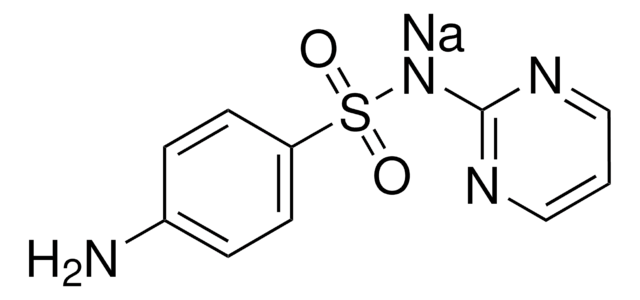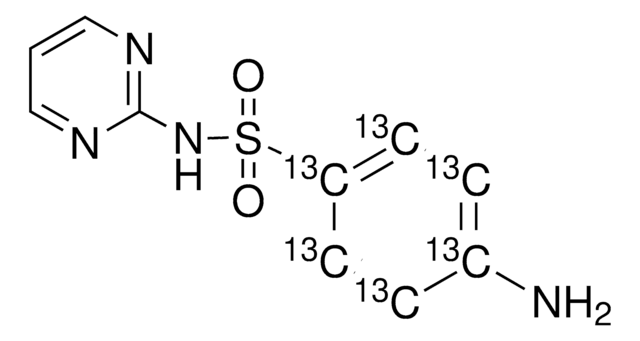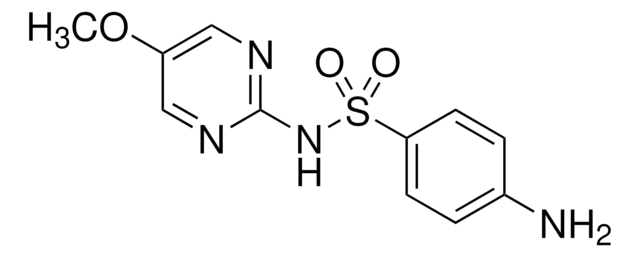S8626
Sulfadiazin
99.0-101.0%
Synonym(e):
4-Amino-N-2-pyrimidinylbenzolsulfonamid, N1-(Pyrimidin-2-yl)-sulfanilamid
About This Item
Empfohlene Produkte
Beschreibung
Solubility - Practically insoluble in water, slightly soluble in acetone, very slightly soluble in ethanol (96 per cent). It dissolves in solutions of alkali hydroxides and in dilute mineral acids.
Assay
99.0-101.0%
Form
powder or crystals
Farbe
white to faint yellow, faint pink
mp (Schmelzpunkt)
253 °C (dec.) (lit.)
Löslichkeit
96% ethanol: very slightly soluble
acetone: slightly soluble
water: practically insoluble
Wirkungsspektrum von Antibiotika
Gram-negative bacteria
Gram-positive bacteria
mycoplasma
Wirkungsweise
DNA synthesis | interferes
enzyme | inhibits
SMILES String
Nc1ccc(cc1)S(=O)(=O)Nc2ncccn2
InChI
1S/C10H10N4O2S/c11-8-2-4-9(5-3-8)17(15,16)14-10-12-6-1-7-13-10/h1-7H,11H2,(H,12,13,14)
InChIKey
SEEPANYCNGTZFQ-UHFFFAOYSA-N
Suchen Sie nach ähnlichen Produkten? Aufrufen Leitfaden zum Produktvergleich
Allgemeine Beschreibung
Anwendung
Biochem./physiol. Wirkung
Sonstige Hinweise
Signalwort
Warning
H-Sätze
Gefahreneinstufungen
Acute Tox. 4 Oral - Aquatic Chronic 2 - Repr. 2
Lagerklassenschlüssel
11 - Combustible Solids
WGK
WGK 2
Persönliche Schutzausrüstung
dust mask type N95 (US), Eyeshields, Faceshields, Gloves
Analysenzertifikate (COA)
Suchen Sie nach Analysenzertifikate (COA), indem Sie die Lot-/Chargennummer des Produkts eingeben. Lot- und Chargennummern sind auf dem Produktetikett hinter den Wörtern ‘Lot’ oder ‘Batch’ (Lot oder Charge) zu finden.
Besitzen Sie dieses Produkt bereits?
In der Dokumentenbibliothek finden Sie die Dokumentation zu den Produkten, die Sie kürzlich erworben haben.
Kunden haben sich ebenfalls angesehen
Unser Team von Wissenschaftlern verfügt über Erfahrung in allen Forschungsbereichen einschließlich Life Science, Materialwissenschaften, chemischer Synthese, Chromatographie, Analytik und vielen mehr..
Setzen Sie sich mit dem technischen Dienst in Verbindung.













